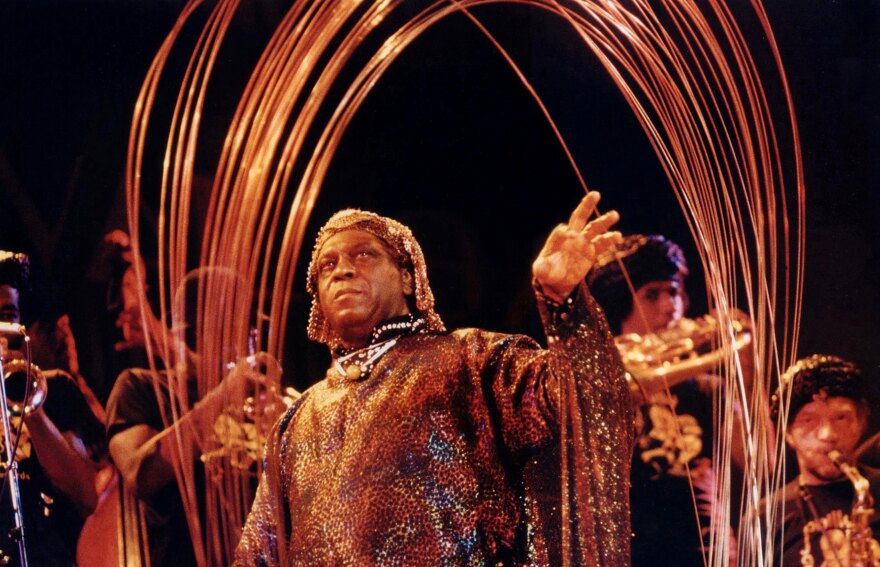“No sun, no moon / All dark amidst the blaze of noon.” So begins the “Total Eclipse” aria from Handel’s opera Samson. A composer from another corner of the galaxy, Sun Ra, put it another way: “The sky is a sea of darkness / when there is no sun to light the way.”
These are but two of the musical touchstones that come to mind as we get ready for a total solar eclipse on April 8. The path of totality will stretch diagonally across the contiguous United States, and here in Philadelphia we’ll see nearly 90% coverage, with a mid-eclipse peak expected at 3:23 p.m. While we watch and wait, here are some related pieces from the classical and jazz canons, some of which you’ll hear on the air at WRTI.
Classical Music for the Eclipse
By John T.K. Scherch, Host of Morning Classical
George Frideric Handel, “Total Eclipse” and “Will the Sun Forget to Streak”
Handel’s oratorios mention at least two eclipses. One is the tenor aria “Total Eclipse” in Samson, which begins with the title character already captured and blinded by the Philistines, lamenting his loss of sight. The other is “Will the Sun Forget to Streak” from Solomon, as the Queen of Sheba sings of an interrupted sun, forgetting to shine, as it could be blocked out by the moon; this imagery depicts her marvel at Solomon’s kingdom.
Alexander Borodin, “Prologue” from Prince Igor
Borodin’s opera Prince Igor, which he never finished — it was completed by his colleagues Nikolai Rimsky-Korsakov and Alexander Glazunov — opens with a chorus praising the glory of the sun. Immediately after follows a solar eclipse, which everyone in the scene takes as a bad omen — certainly to be expected in opera, though this one actually has a happy ending.
Carl Nielsen, Helios Overture
One of Carl Nielsen’s most famous works, this concert overture paints a picture of the rising, shining, and then setting sun over the Aegean Sea (which will be accurate for this eclipse, as it’s nowhere near the path). The piece begins in “tranquility and darkness,” of which there will be brief moments across the country as the eclipse moves along its path of totality, and then the sun makes its joyous reappearance.
Richard Strauss, “Sunrise,” from Also Sprach Zarathustra
If you can’t hear the piece in your head from the title, I’ll give you a hand: think of the opening to Stanley Kubrick’s 2001: A Space Odyssey. One of the most recognizable musical moments in cinema, it’s also one of the most famous depictions of a solar eclipse, as we pan away from the angle of obstruction.
John Tavener, Total Eclipse
This eclipse is the “blinding” conversion of St. Paul, says John Tavener. He describes the work itself as a “metanoia,” which translates roughly from Greek to “conversion,” and it musically paints every beautiful, ugly, intense, and awesome moment in the process. The blasts of dissonant saxophone at the beginning represent the Crucifixion, and the conversion is told through Tavener’s choral music in his signature style, influenced by Eastern Orthodox church music.
Jazz for the Eclipse
By Greg Bryant, Host of Evening Jazz and The Get Down
Sun Ra and His Arkestra, “When There Is No Sun”
Sun Ra is a beacon for the avant and abstract, but some of his most moving moments on record exhibit a simplicity that best drives home his solar and planetary messages. On this track from 1978, John Gilmore's mournful tenor saxophone and Ra's lyrics evoke the “sea of darkness” that spans the heavens “when there is no sun.” This musical moment sets the atmosphere for gratefulness and reflection on something as powerful and as overlooked as the center of our Solar System.
Bobby Hutcherson, “Total Eclipse”
Bobby Hutcherson's multifaceted melodies are severely under-celebrated. This vibraphonist wrote in a style that often married singable melodies with a dreamy harmonic underpinning. “Total Eclipse” is one such melody that echoes today’s moment with an exceptional cast that includes standout contributions by Hutcherson’s musical partner Harold Land on tenor sax.
Eric Dolphy, “Eclipse”
Eric Dolphy’s second recording as a leader, Out There, may be one of his most comprehensive albums. Through each of the seven tracks, he has compelling performances on each of the four reed instruments that were the staples of his arsenal. While the title track looks ahead to the energy and sound of his masterpiece, Out To Lunch, Dolphy also looks back to an early composition by his musical big brother, Charles Mingus. This performance of “Eclipse” is punctuated by some stirring Dolphy clarinet and exploratory cello work by Ron Carter.
Freddie Hubbard, “Eclipse”
In hindsight, The Black Angel, though memorable on its own, has proven to be an album that captures trumpeter Freddie Hubbard in transition. Its grooves and explorations certainly foreshadow what was to come as Hubbard leapt into the 1970s breathing more fire and getting even funkier. His composition “Eclipse” captures him at his most contemplative and reflective before ascending to commercial and critical success.
The Fourth Way, “The Sun and the Moon Have Come Together”
In the late 1960s, The Fourth Way was a Bay-Area collective that had all of the ingredients to become one of music’s most dominant jazz-rock bands. Despite unique instrumentation (violin, electric piano, bass, drums), major label visibility (Capitol Records), and appearances on the jazz and rock festival scene, the group has now been largely forgotten. The first of their three albums is particularly memorable, and would serve as a template for the final two: groovy expressions that periodically dip into the avant-garde. This title track, in particular, rewards repeated listens.



